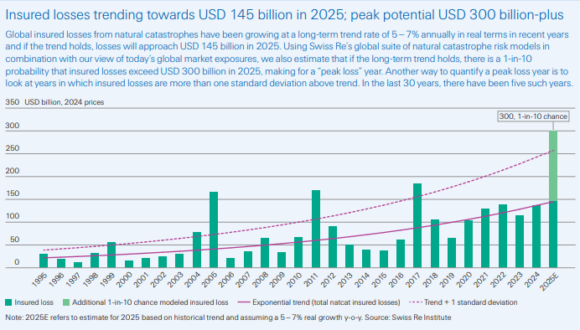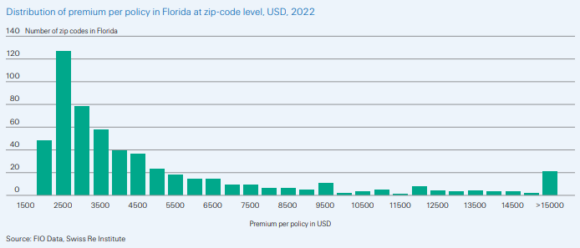World insured losses from pure catastrophes hit US$137 billion in 2024, following the 5%-7% annual progress charge that has been the norm lately, in accordance with Swiss Re evaluation.
If this pattern continues, international insured losses will strategy US$145 billion in 2025, primarily pushed by secondary perils corresponding to extreme convective storms (SCS), floods and wildfires, mentioned the Swiss Re sigma report titled “Pure catastrophes: insured losses on pattern to USD 145 billion in 2025.”
Whereas loss severity for nat cats is rising globally, North America accounted for nearly 80% of world insured losses in 2024, because of the area’s publicity to extreme thunderstorms, hurricanes, floods, wildfires, and earthquakes, the report mentioned. (Editor’s be aware: the 80% determine will be discovered on web page 29 of the primary report, desk 3).
“After a number of years of underwriting losses, owners’ premiums solely lately caught up with housing alternative prices. Nonetheless, ongoing underwriting losses recommend that premiums are nonetheless not commensurate with the danger, and that additional alignment is critical to maintain insurance coverage enterprise.”
“As has been the case lately, in 2024 many of the international insured losses have been pushed by secondary perils, specifically extreme convective storms within the US,” Swiss Re mentioned, noting, that the lethal fires in Los Angeles in January this yr level to a different yr of excessive losses from secondary perils.
World financial losses from catastrophes have been US$318 billion, the best since 2017 (US$448 billion in 2024 costs). “Round 43% have been coated by insurance coverage, highlighting the continued existence of huge safety gaps in lots of elements of the world, together with in superior economies,” the report mentioned. The 2024 insurance coverage safety hole of $181 billion — up from $177 billion in 2023 — is the distinction between total financial losses and the quantity coated by insurers.

Peak-Loss Years
Regardless of the excessive price ticket from secondary perils, Swiss Re warned, it’s major perils (tropical cyclones and earthquakes) that stay the largest contributor to insured losses total. Swiss Re pointed to the 5 so-called “peak loss” years which have occurred within the final 30 years (1999, 2004, 2005, 2011 and 2017), when annual losses have been method above pattern.
In 2017 – the final peak-loss yr – Hurricanes Harvey, Irma and Maria drove international insurance coverage losses to 111% above pattern, however Swiss Re warned that the next interval of quiet since then didn’t gradual the underlying progress of danger.
Swiss Re’s pure disaster fashions level to a 1-in-10 chance that international insured losses may attain as excessive as US$300 billion in 2025, creating subsequent peak-loss yr. (See above graphic).
Swiss Re cautioned that peak loss years, “on account of both the buildup of many loss occasions or these from a number of particular person massive occasions, shouldn’t be thought of a freak prevalence.” “Historical past repeats, and it’s not a query of if, however when the insurance coverage business will face the following peak loss yr.”
Los Angeles Wildfires
Though 2025 started with document insured wildfire losses of roughly $40 billion in Los Angeles, Swiss Re defined that the fires on their very own won’t trigger a notable deviation from the annual loss progress pattern for pure catastrophes (of 5%-7%).
“Of the overall losses, insurance coverage claims for residential property have been at the least US$30 billion,” mentioned Swiss Re, estimating it will possible generate a loss ratio of round 200% for owners’ insurers in California.
“Assuming an round 50% base load, the loss ratio is heading in direction of 250%. The final time the loss ratio was of comparable magnitude was in 2017 (201%) and 2018 (176%), when wildfires in California triggered document losses for that point,” the report added.
“We estimate that two-thirds of payouts to cowl the hearth losses will come from major insurers, one-third to be paid by reinsurers. The dimensions of losses was so massive that many excess-of-loss reinsurance covers have been triggered. The reinsurance share of loss would have elevated additional with an excellent larger loss.”
In years when losses are near pattern, Swiss Re mentioned, major insurers cowl the vast majority of property claims, however when main disasters strike and losses rise nicely above pattern, “reinsurers step in to cowl greater than half of the losses in extra of pattern.”
Owners Insurance coverage
Owners in catastrophe-prone states are feeling the ache of rising premiums, as their insurers search to return to underwriting profitability.
Within the US, owners’ insurers have seen their web incurred losses improve by 8% yearly since 2018 – a pattern pushed by a post-COVID surge in development and claims prices. “The consequence of the latter is that home-owner insurers have seen a number of years of underwriting losses,” Swiss Re mentioned.
“After a number of years of underwriting losses, owners’ premiums solely lately caught up with housing alternative prices. Nonetheless, ongoing underwriting losses recommend that premiums are nonetheless not commensurate with the danger, and that additional alignment is critical to maintain insurance coverage enterprise.”
The states with highest exposures to pure catastrophes are additionally these the place, on the whole, home-owner premiums are highest, the report mentioned, pointing to 5 states – Florida, Texas, California, Louisiana and Colorado – which account for round 50% of all pure disaster losses within the U.S.
“Traditionally, Louisiana has suffered the best pure disaster losses per coverage, adopted by Florida. These have principally been on account of losses emanating from hurricane occasions,” the report confirmed.

“House owner premiums per family within the state of Florida are twice the nationwide common,” the report mentioned, noting that in states with larger common premiums (corresponding to Florida), extraordinarily excessive premium ranges are localized.
For instance, in 11% of the Florida’s zip codes, premiums per coverage have been above US$10,000, the report mentioned. “These are sometimes coastal zip codes with highest danger of storm surge and/or wind injury.”
{Photograph}: A home lies toppled off its stilts after the passage of Hurricane Milton, in Bradenton Seashore on Anna Maria Island, Fla., Oct. 10, 2024. (AP Picture/Rebecca Blackwell, File)
Associated:
Matters
Developments
Revenue Loss
Claims
